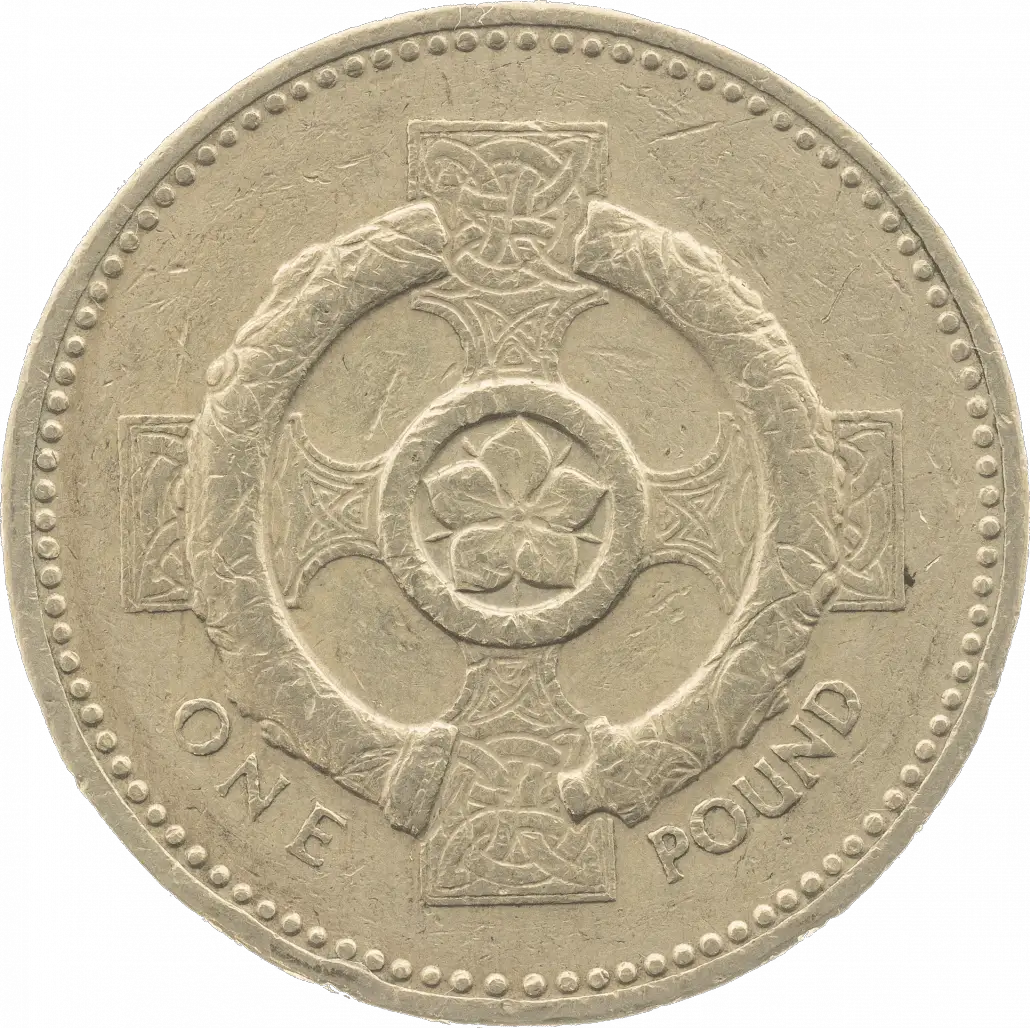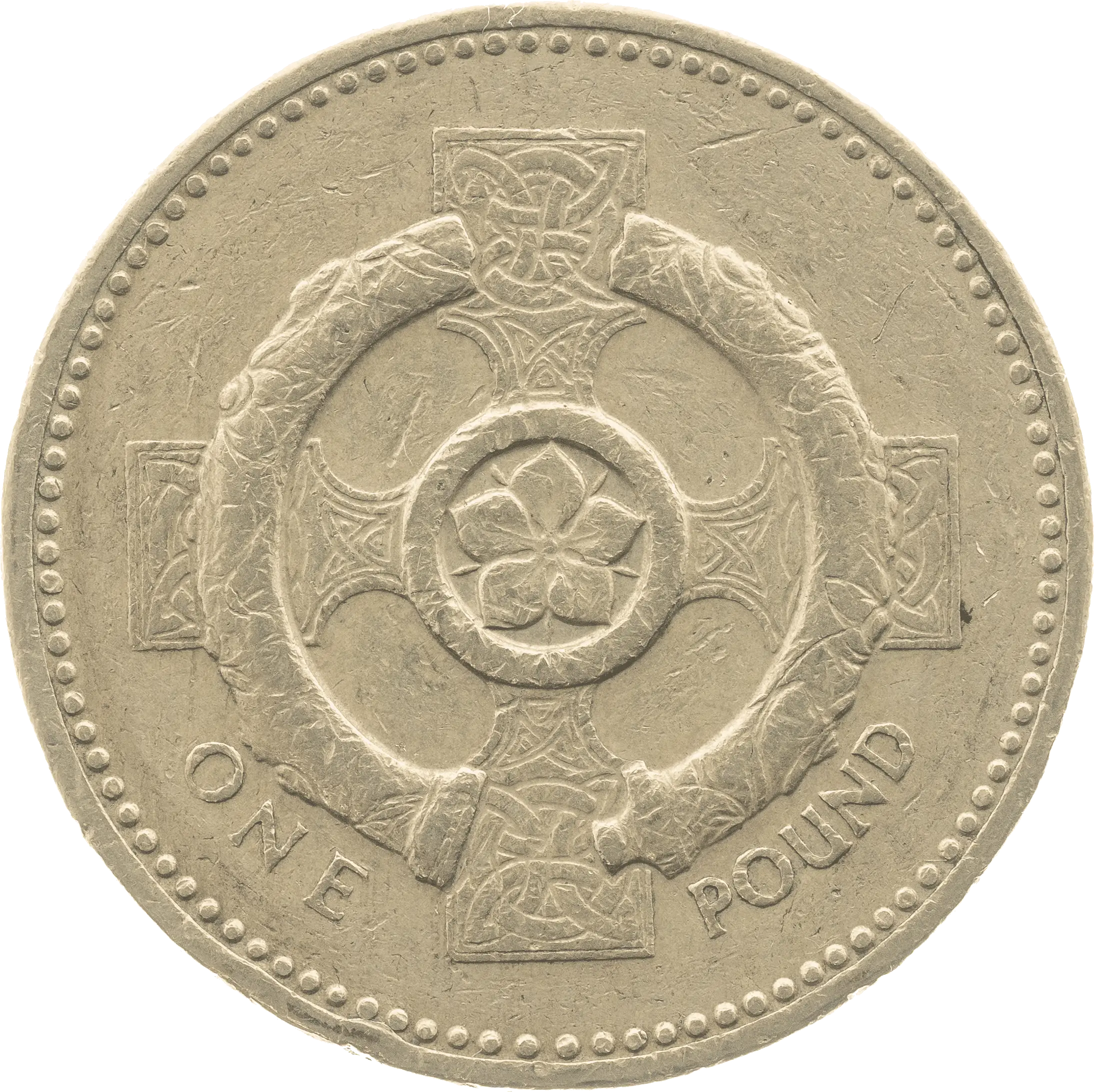Add the Celtic Cross £1 coin to your collection, especially if you are looking to complete the 4-part series of round pound coins. It is the third in a 4-part coin series depicting heraldic emblems and is considered to be the 18th rarest £1 coin in circulation.
How Much Are The Celtic Cross £1 Coins Worth?
As with any coin, the Celtic Cross £1 Coins price will be somewhat determined by which year the coin was minted. Expect to find the coins selling as follows:
- 1996 Celtic cross = estimated value of £1.96
- 2001 Celtic cross = estimated value of £1.74
The 1996 version had a mintage of 89,886,000, whilst the 2001 version had a mintage of 63,968,065. There were also coins released in brilliant uncirculated sets and proofs.
The Celtic Cross design was re-issued in 2008 as a collector coin in silver and gold as part of a 14-coin commemorative set marking the 25th anniversary of the £1 coin.
Design Of The Celtic Cross £1 Coin

The Celtic Cross £1 coin is part of the Round Pound coins that were issued each year with a special reverse design to represent an emblem of the UK, Scotland, Wales, Northern Ireland, or England. The reverse was changed each year from1983 to 2008 to reflect a design that represented the United Kingdom or one of its four constituents.
The Celtic Cross £1 coin designs were part of a 4-part series representing the four constituent countries of the UK using heraldic emblems. This series started in 1994 with the Lion Rampant representing Scotland followed by the 1995 Dragon representing Wales. In 1996, the Celtic Cross and Torc heraldic image was used to represent Northern Ireland. In 1997, an image of the Three Lions represented England.
This 4-part series of heraldic emblems on the reverse side of the round pound would repeat starting again in 1999 through 2002. Northern Ireland would be again represented on the 2001 coin.
Both of the Celtic Cross coins were part of the round £1 coins. The British £1 coin is a denomination of the pound sterling. The original £1 coin replaced the Bank of England £1note that was no longer issued after 1984 but was not removed from circulation until March 11, 1988.
The round pounds are no longer considered legal tender. After 2017, when the £1 coin was redesigned to be a 12-shaped coin, the older £1 coins could only be redeemed at banks. For a limited time, some retailers would also accept them.
The edge of the coin is milled with an inscription and a small crosslet as a mint mark that represents Llantrisant in South Wales where the Royal Mint has been based since 1968. The shape of the cross alludes to Llantrisant, translated to mean Church or Parish of the Three Saints.
The milled edge with an incuse inscription was used in an attempt to protect the coins from debasement. The edge of the Celtic Cross £1 coin is a milled edge that includes the inscription to read DECUS ET TUTAMEN. Translated, this means “An ornament and a safeguard.” It is a quote from Virgil’s Aeneid. It is also sometimes interpreted to mean, “Glory and defence”.
The 1996 and 2001 versions of the coin represent Northern Ireland featuring a Celtic Cross and Torc on the reverse side. The image depicted a Celtic Cross with a Pimpernel Flower in the middle surrounded by an ancient Torc.
The words ONE POUND are found toward the bottom centre of the coin divided by the lower part of the cross.
The Celtic Cross £1 coin is 22.50 millimetres in diameter and weighs 9.50 grams in a Nickel-brass alloy with a thickness of 3.15 mm. The £1 Round series of coins were the only UK coin to have this specific yellow colour.
Northern Ireland was first represented on the £1 round coin in 1986 and 1991 with the same flax plant floral emblem design used for both years. This time Northern Ireland would be represented with a different design on the 1996 and 2001 Celtic Cross coin.
In 2006 Northern Ireland would again be represented on the Egyptian Arch Railway Bridge coin and again in 2010 with the Coat of arms of Belfast. In 2014, the original flax plant emblem would make its appearance once again on the Flax and Shamrock £1 coin.
Northern Ireland has not been represented on the coin since the £1 coin changed to be a 12-sided, bi-metallic coin in 2017.
1996 Obverse
The obverse of the 1996 Celtic Cross coin features the portrait of Queen Elizabeth II as designed by Raphael Maklouf in which the Queen wears the George IV State Diadem, officially the Diamond Diadem. The crown was made in 1820 for King George IV. The inscription surrounding her portrait was ELIZABETH II D.G. REG.F.D. followed by the minting year.
Translated, the inscription means Elizabeth II Dei Gratia Regina, by the grace of God, Queen, Defender of the Faith. The designer’s initials RDM can be found at the very bottom left-hand corner of the Queen’s portrait, in the neck truncation.
2001 Obverse
The obverse of the 2001 Celtic Cross coin is the design of Ian Rank-Broadley. This new designer was more of a realist than the previous designer and not afraid to show the queen looking a bit more mature. He also made the image as large as he could. He depicted Her Majesty wearing the “Girls of Great Britain and Ireland” diamond tiara. The tiara was a wedding gift from Queen Mary, her grandmother, in 1947.
The inscription surrounding her portrait was ELIZABETH II D.G. REG.F.D. followed by the minting year. Translated, the inscription means Elizabeth II Dei Gratia Regina, by the grace of God, Queen, Defender of the Faith. The designer’s initials IRB are seen directly under the neckline of the image.
The reverse design on both the 1996 and the 2001 Celtic Cross coin represents Northern Ireland.
What Does The Coin Represent?
Northern Ireland is one of the four parts of the United Kingdom. The designer chose to represent the country on the heraldic emblems series of round pound coins with a Celtic Cross and Torc.
The image of the Celtic Cross and Torc is sometimes referred to as a Celtic Cross, Broighter collar and pimpernel, or the Celtic Cross and Torc or Torque meaning neck ring.
The Celtic Cross originated as a way for Druids to worship the sun god, Taranis. The original symbol was a solar wheel. When the Celtic people converted to Christianity, they kept the wheel and changed it to add a cross, which reflected their new religious beliefs.
The symbol connects faith to heritage and signifies the knowledge, strength, and compassion needed to manage life’s ups and downs.
The Celtic Torc was an important piece of Celtic jewellery. The jewellery has been traced back to the Viking Age to represent devotion to family and the power that the family held.
It was worn from before 1200 BC to as late as 600 AD. The symbol was a powerful one that may have represented the free-born status of the wearer. It was worn to identify that the person was of high rank. The jewellery was worn as a necklace or rings worn around the arms and wrists. They were usually crafted out of gold. The term Torc means to twist.
The image features the Broighter collar over a Celtic Cross. The Broighter collar was discovered in 1896 in a hoard of gold Iron Age artefacts near Lough Foylel in Northern Ireland. It is said to be the finest example of Irish La Tene gold working in Europe.
Celtic Cross Coin Designer
Norman Sillman designed the Celtic Cross coin that would represent Northern Ireland as one of the parts of the United Kingdom. His design was chosen from a drawing provided by the College of Arms.
Sillman was a British sculptor and a coin designer. He was a sculptor in London until 1956, spending a lot of time drawing images of animals from the London Zoo that he would later sculpt.
The Royal Mint commissioned him to design a coin in 1956 for Bermuda. He also designed for the Birmingham Mint, York Mint, Metalimport, Sandhill Ltd, Danbury Mint USA, Franklin mint USA, and others. He ultimately designed coins for at least 30 countries.
Besides coins, he also designed several medals for Britain.
Also for Britain, he designed the Scottish Commonwealth Games Two-Pound Coin, and this four-part series for the £1 coin featuring heraldic emblems for each of the four countries that make up the UK.
Where Can You Buy The Celtic Cross Coin?
Online sites like eBay are a quick and easy way to find coins like the Celtic cross £1 coins. Whenever you shop or sell online, just be sure to do enough research first, so you know exactly what to look for. The exact price is going to depend on what condition the coin is in, as well as the year it was minted.
The Royal Mint has a great online shop as well if you are looking for uncirculated coins specifically.

